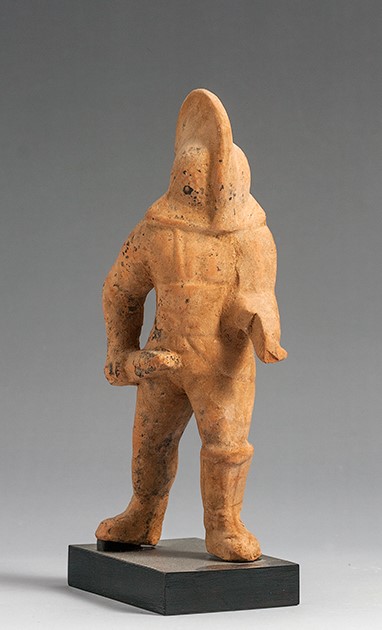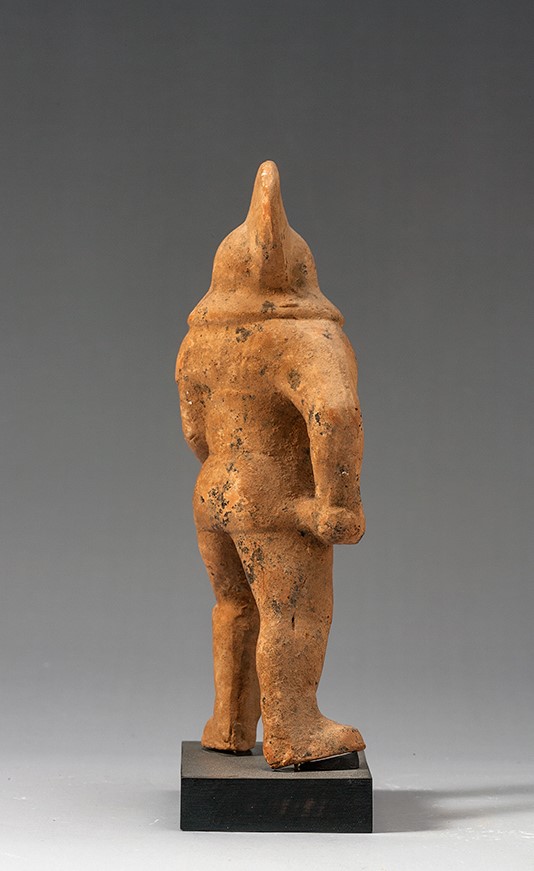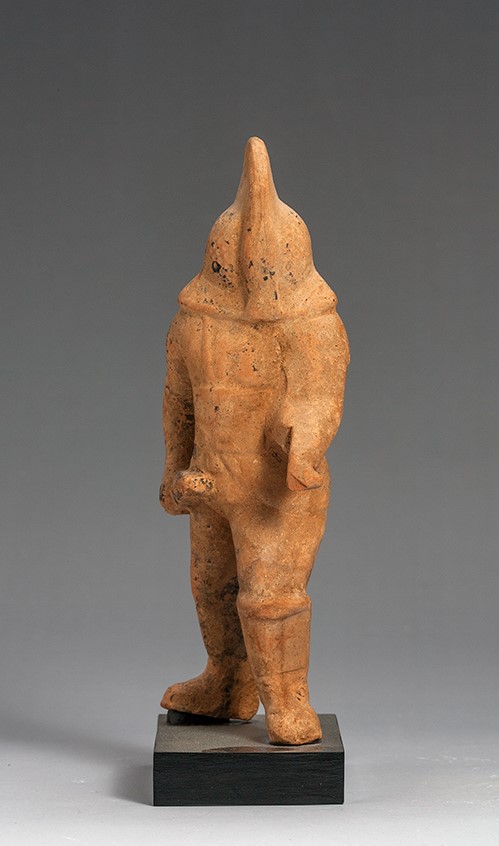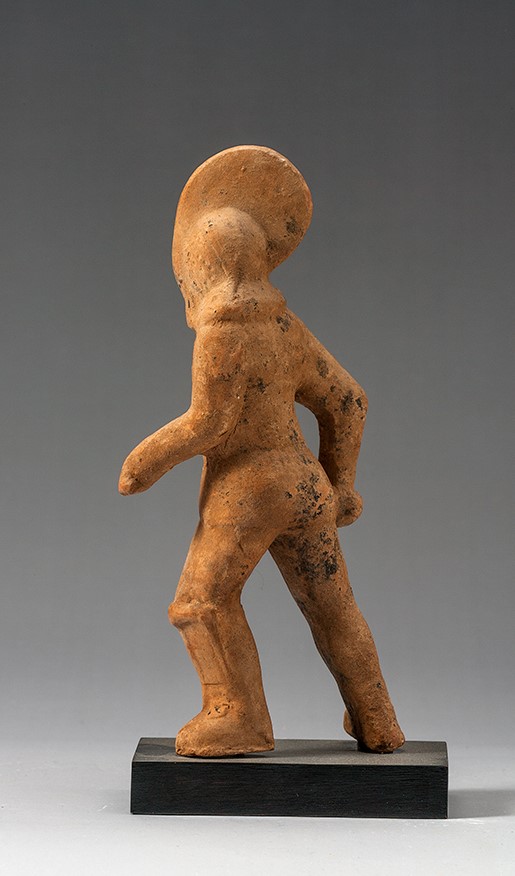Acquisition number: 1975.20
Intact but for the shield which is missing. Smoothly-finished, orange-buff clay with traces of black paint all over.
The figure lunges forward on his left leg. He wears a helmet that totally encloses the head, body armour and a single rectangular greave on the left leg. He carries a short sword in his right hand. The left arm is broken where the shield was attached. One can see the lattice on the front of the helmet through which the gladiator could see, and the tie at the front of the breastplate.
This solid thick-set figure belongs to the heavily-armed type known as the hoplomachus (or ‘Samnite’).
Title: Figurine of a Gladiator - 1975.20
Acquisition number: 1975.20
Author or editor: J.R. Green
Culture or period: Roman Imperial
Date: 1st century AD.
Material: Clay - Terracotta
Object type: Sculpture and figurines
Dimensions: 162mm (h)
Origin region or location: Türkiye
Origin city: Said to be from Asia Minor.
Display case or on loan: 12
Keywords: Roman, Imperial, Asia Minor, Figurine, hoplomachus, Samnite
Charles Ede Ltd (London), Greek and Roman Terracottas (November 1975) no. 20 (ill.); J.R. Green with B. Rawson, Catalogue of Antiquities in the Australian National University, A.N.U. (Canberra, 1981) 86.
1975.20
Figurine of a Gladiator
Purchased; said to be from Asia Minor. Ht 16.2cm.
Intact but for the shield which is missing. Smoothly-finished, orange-buff clay with traces of black paint all over.
The figure lunges forward on his left leg. He wears a helmet that totally encloses the head, body armour and a single rectangular greave on the left leg. He carries a short sword in his right hand. The left arm is broken where the shield was attached. One can see the lattice on the front of the helmet through which the gladiator could see, and the tie at the front of the breastplate.
This solid thick-set figure belongs to the heavily-armed type known as the hoplomachus (or ‘Samnite’).
Compare the similar figurines in J.B.Ward-Perkins and A. Claridge, Pompeii A.D. 79 (London 1976) nos 299-302, esp. no. 301 which is of the same type as that here. There is a good survey of representations of gladiators, their types and combats in Enciclopedia dell’Arte Antica. Classica e Orientale iii, 937-947. An exhibition in Lattes prompted an excellent catalogue, Les gladiateurs (Lattes 1987) and a colloquium, C. Domergue, Chr. Landes and J.-M. Pailler (eds), Spectacula - I. Gladiateurs et amphithéâtres (Actes du Colloque tenu à Toulouse et à Lattes les 26, 27, 28 et 29 mai 1987) (Lattes 1990); L. Jacobelli, Gladiators at Pompeii (Los Angeles 2003); see also F. Savi, I gladiatori. Storia, organizzazione, iconografia (Rome 1980); M. Flecker, Römische Gladiatorenbilder : Studien zu den Gladiatorenreliefs der späten Republik und der Kaiserzeit aus Italien (Wiesbaden 2015). There is also a good introduction by H. Dodge, Spectacle in the Roman World (London 2011), ch. V.
For a thorough study of inscriptional and other documentary evidence, see L. Robert, Les gladiateurs dans l'orient grec (Paris 1940, repr. 1971) and G. Ville, La gladiature en occident des origines à la mort de Domitien (BEFAR no. 245, Rome 1981). For a thorough treatment of images inspired by the spectacles of the arena, see M. Papini, “Munera gladiatoria e ventiones negli immagini”, MemLinc 19, 2004, 5-221. On their significance, see further Chr. Landwehr and A. Hönle, “Ein Reliefkrug aus Lucrino”, Mitteilungen des Deutschen Archäologischen Instituts, Römische Abteilung 94, 1987, 223-240 (esp. 231ff.); E. Gunderson, “The Ideology of the Arena”, Classical Antiquity 15, 1995, 113-151; R. Sablayrolles, “La mort en direct: le tragique du gladiateur”, Pallas 19, 1998, 343-351; D.S. Potter and D.J. Mattingly, Life, Death, and Entertainment in the Roman Empire (Ann Arbor 1999); D.G. Kyle, Spectacles of Death in Ancient Rome (London 1998) and E. Köhne and C. Ewigleben (eds.), Gladiators and Caesars. The Power of Spectacle in Ancient Rome (London 2000). Some texts relating to gladiatorial combats are included in A. Mahoney, Roman Sports and Spectacles (Newburyport, MA, 2001). There is also a handy and readable coverage by L. Jacobelli, Gladiators at Pompeii (Los Angeles: Getty Publications, 2003). An interesting contribution is G.G. Fagan, The Lure of the Arena: Social Psychology and the Crowd at the Roman Games (Cambridge 2011). Another good study of representations is that by M. Papini, Munera gladiatoria e venationes nel mondo delle immagini (Memorie (Accademia nazionale dei Lincei. Classe di scienze morali, storiche e filologiche) ; ser. 9, v. 19, fasc. 1., Rome 2004). There is a useful series of articles in T. Wilmott (ed.), Roman Amphitheatres and Spectacula: A 21st-Century Perspective (BAR International Series 1946, Oxford 2009). More recently, an excellent and well-illustrated discussion and overview by K.M.D. Dunbabin, Theater and Spectacle in the Art of the Roman Empire (Ithaca NY, 2016) 171-229.
Representations of gladiators in general were of course very popular in most parts of the Roman Empire and we find them in relief sculpture, paintings and mosaics as well as decorating minor objects such as lamps and pottery; terracottas could be acquired as souvenirs or given as presents, for instance at the festival of the Saturnalia.
Charles Ede Ltd (London), Greek and Roman Terracottas (November 1975) no. 20 (ill.); J.R. Green with B. Rawson, Catalogue of Antiquities in the Australian National University, A.N.U. (Canberra, 1981) 86.




